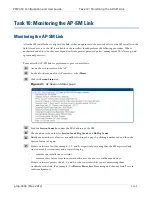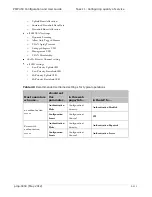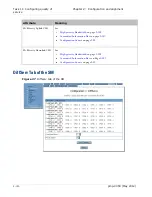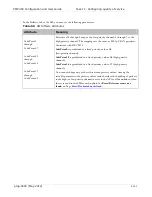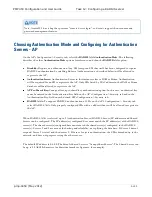
Task 11: Configuring quality of
service
Chapter 2: Configuration and alignment
2-108
pmp-0050 (May 2012)
When an SM successfully registers and authenticates, if BAM or Prizm has CIR configuration data for the
SM, then messages make the CIR configuration available to the SM, depending on the Configuration
Source setting.
The operator can disable the CIR feature in the SM without deleting the CIR configuration data.
Bandwidth from the SM Perspective
In the SM, normal web browsing, e-mail, small file transfers, and short streaming video are rarely rate limited
with practical bandwidth management (QoS) settings. When the SM processes large downloads such as
software upgrades and long streaming video or a series of medium-size downloads, the bucket rapidly drains,
the burst limit is reached, and some packets are delayed. The subscriber experience is more affected in cases
where the traffic is more latency sensitive.
Interaction of Burst Allocation and Sustained Data Rate Settings
If the Burst Allocation is set to 1200 kb and the Sustained Data Rate is set to 128 kbps, a data burst of 1000 kb
is transmitted at full speed because the Burst Allocation is set high enough. After the burst, the bucket
experiences a significant refill at the Sustained Data Rate. This configuration uses the advantage of the
settable Burst Allocation.
If both the Burst Allocation and the Sustained Data Rate are set to 128 kb, a burst is limited to the Burst
Allocation value. This configuration does not take advantage of the settable Burst Allocation.
If the Burst Allocation is set to 128 kb and the Sustained Data Rate is set to 256 kbps, the actual rate will be
the burst allocation (but in kbps). As above, this configuration does not take advantage of the settable Burst
Allocation.
High-priority Bandwidth
To support low-latency traffic such as VoIP (Voice over IP) or video, the system implements a high-priority
channel. This channel does not affect the inherent latencies in the system but allows high-priority traffic to be
immediately served. The high-priority pipe separates low-latency traffic from traffic that is latency tolerant,
such as standard web traffic and file downloads.
The number of channels available to the AP is reduced by the number of SMs configured for the high-priority
channel. With this feature enabled on all SMs, an AP can support 100 SMs (instead of 200).
A module prioritizes traffic by
reading the Low Latency bit (Bit 3) in the IPv4 Type of Service (ToS) byte in a received packet. Bit 3 is
set by a device outside the system.
reading the 802.1p field of the 802.1Q header in a received packet, where VLAN is enabled on the module.
Summary of Contents for PMP 450
Page 1: ...Cambium PMP 450 Configuration and User Guide System Release 12 0...
Page 6: ......
Page 22: ......
Page 172: ......
Page 173: ...PMP 450 Configuration and User Guide pmp 0050 May 2012 3 1 Chapter 3 Reference information...
Page 178: ......












